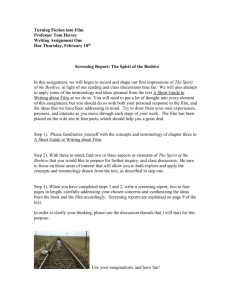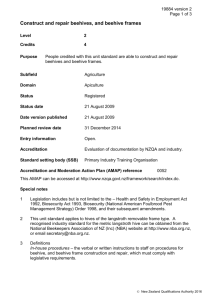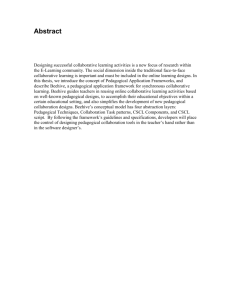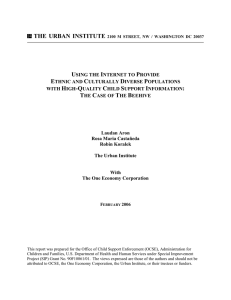File
advertisement
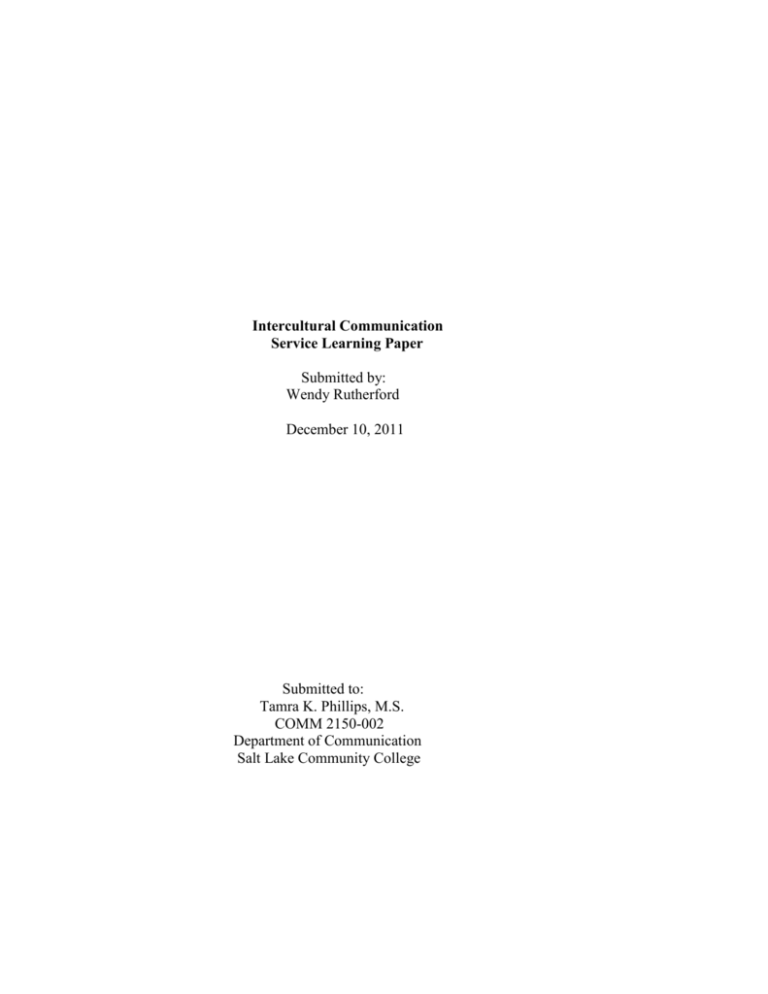
Intercultural Communication Service Learning Paper Submitted by: Wendy Rutherford December 10, 2011 Submitted to: Tamra K. Phillips, M.S. COMM 2150-002 Department of Communication Salt Lake Community College Community Partner: For my service learning project, I volunteered at the BeeHive Home for Senior Citizens. The contact information is listed below: BeeHive Homes Connie Sperry, Care Director BeeHive Homes 711 East Pioneer Road, Draper, Utah 801-495-3100 Email: indigoblue42@hotmail.com Project The first BeeHive assisted living home was built by Mr. Twayne Walker in 1987 in Meridian, Idaho. This idea was based on the concept that the elderly deserve a comfortable, clean, and affordable family style home when they reach a point where they need assisted care. Many assisted living homes do not provide a pleasant atmosphere where residents can live happily and the cost of most facilities is out of reach for many of the elderly and their families. BeeHive is a beautiful family style home for those who need assisted care. As a volunteer, my goal was to incorporate some activities that would enhance the daily lives and bring companionship, joy, and happiness to some of the residents at the BeeHive Home. I soon realized that I could make a bigger difference by limiting my time to a few residents rather than trying to incorporate activities for all of the residents. For most of my volunteered time, I visited with Gene McClary, an 81 year old retired electrical engineer who was diagnosed with a brain tumor in March 2011. The doctors removed the tumor and he came to live at the BeeHive Home for assistance in his recovery. His mind is very keen; however, his frail physical body does not allow him to live life as he would like to. His wife passed away about 18 months ago and he has three adult married children. He receives one visit a week from his daughter that lives in Utah. He feels that he is capable of living on his own, but his children feel that he is safer to remain at the BeeHive Home. It makes him sad and frustrated that he Page 2 Intercultural Communication Service Learning Paper BeeHive Home cannot live on his own. One of his passions is to garden. For one of my visits, I purchased 18 flowers and pots for each of the BeeHive residents. My family, along with Gene and a few other residents from BeeHive, planted each of them and then we assisted Gene with delivering them to each of the residents. It was such a wonderful experience for my entire family. Even my children commented on how it made them feel good to see Gene feel important and also to see each face light-up as Gene handed them a potted flower. Cultural Group: At the BeeHive Home, I visited with senior citizens (approximate ages of 70-90) who live a very slow paced life and are all extremely lonely. Even though they have each other, none of them seem to seek out those relationships. They are no longer in the work force or living in a busy family lifestyle. All of the residents at BeeHive are challenged with health issues which adversely affects many aspects of their choices and quality of life. Challenges One of my biggest challenges was to find activities that the senior citizens could do physically, mentally, and find enjoyment in doing. My original plan was to do activities for a group of residents; however, BeeHive already provides this once a week and only a handful of interested individuals attend. I then decided to focus my time on visiting one or two of the resident’s. My other challenge was to find the time in my busy schedule to make this a part of my weekly routine. I have been able to do this, but sometimes it has required me to juggle a few other activities for my children. Page 3 Intercultural Communication Service Learning Paper BeeHive Home Theory I would like to apply the dialectical approach to my service learning project. The dialectical approach combines the three approaches of social science, interpretive, and critical; however, it also recognizes that these three approaches are interconnected and sometimes contradictory. The social science approach helps us to “describe and predict behavior” (Phillips, 2011, p. 31). Specific communication and cultural differences might create different views of the world. If we understand these differences better, it can help make it easier to interact with those of other cultures and possibly even help predict intercultural conflicts. The interpretive perspective allows us to “describe and understand behavior” (Phillips, 2011, p. 31). This helps us to see our own culture. This perspective gives us an opportunity to confirm what we predicted in a hypothetical social science study. In the critical approach, we try to “describe and change behavior” (Phillips, 2011, p. 31). It’s important to recognize that the cultures access to financial, political, and material resources affect their experiences. If we can change some of the unfair ideas that we have about other cultures, it will help us gain more equality. “A dialectical approach requires that we move beyond simply acknowledging the contributions of the three perspectives and accept simultaneously the assumptions of all three” (Martin & Nakayama, 2010. p.73). This approach is based on the assumption that human behavior is predictable, creative and changeable. Rather than choose any one of these approaches, a dialectical approach emphasizes the processual, relational, and contradictory nature of intercultural communication. Page 4 Intercultural Communication Service Learning Paper BeeHive Home “Processual refers to how interaction happens rather than to the outcome” (Martin & Nakayama, 2010. p.72). The way people adapt, communication, and other patterns are continually changing (dynamic). We know that individuals change, which in turn, means that the cultures will change as well. A dialectical perspective also emphasizes the relational aspect of intercultural communication. It looks closely at the relationship and “the importance of viewing these holistically rather than in isolation” (Martin & Nakayama, 2010. p.72). If we look at the different cultural group’s values, beliefs, histories, wealth available, etc., it helps us to have a better understanding of the culture. A third characteristic of the dialectical perspective “involves holding contradictory ideas simultaneously” (Martin & Nakayama, 2010. p.72). This is opposite of how the culture in the United States currently thinks, which is to emphasize dichotomous thinking (such as “good and evil, “far and near”, “high and low”, “long and short”, etc.). There are six dialectics that characterize intercultural communication. In the CulturalIndividual Dialectic, it points out that we share communication patterns with members of the groups that we belong to; however, we also have completely idiosyncratic (particular to one person and no one else) patterns as well. The Personal-Contextual Dialectic emphasizes that we need to focus simultaneously on the person and the context in order to fully understand intercultural communication. In the Differences-Similarities Dialectic, it shows that within a culture, we share the same and yet we also have differences in values, language, nonverbal behavior, conflict resolution, etc.. Page 5 Intercultural Communication Service Learning Paper BeeHive Home The Static-Dynamic Dialectic recognizes that some patterns remain relatively the same (static); however, other patterns change over time (dynamic) within our cultural group. In order to understand intercultural communication, we must recognize both the static and dynamic aspects of all relations. In the History/Past-Present/Future Dialectic, it reveals that in order to understand intercultural communication, we need to focus simultaneously on the past and the present. The Privilege-Disadvantage Dialectic identifies that within in the same cultural group, we recognize that people may be privileged in some contexts and disadvantaged in other contexts. The dialectical approach is not a specific theory; however, “it is a lens through which to view the complexities of the topic” (Martin & Nakayama, 2010. p.76). This approach allows us to look at the issues and ideas from different angles, have contradicting ideas, but always attempt to see things in a processual, relational, and holistic way. Analysis To illustrate the Cultural-Individual Dialectic, I noticed that within this cultural group, there are many traits that are shared. Many of them love listening to the radio rather than watching the television; they all love to listen and sing to music from the 1940-1960’s; they all love to reminisce about their lives when they were between the ages of 20-50; they all having failing physical bodies; and they all love visitors from outside of the BeeHive home. However, I also learned that there were also many idiosyncratic patterns as well. There is a woman who loves for someone to read to her, while the others would rather read on their own. There is one woman who seems to be extremely happy and joyful over everything, while the others seem Page 6 Intercultural Communication Service Learning Paper BeeHive Home more frustrated with their lifestyle and limited choices. There are few residents that still have very keen minds; however, the majority of them have failing minds as well as failing physical bodies. To show how the Privilege-Disadvantage Dialectic applies, I saw within this cultural group that many of them are privileged in that they all have a maid service that clean their rooms, make their beds and even do their laundry. They have a cook that fixes all of their meals and does all the dishes. They have unlimited free time to do whatever they would like to. However, they are disadvantaged in that their failing health and/or failing minds limits their choices for living the life that they would like to. They are unable to drive anywhere, unable to eat certain things due to medical issues, unable to do the activities that they have a passion for, and most importantly, they are unable to constantly be around those that they love. To demonstrate the Static-Dynamic Dialectic, I recognized that some patterns remained relatively the same; however, other patterns changed over time. I learned that all of them had discovered and developed passions/patterns throughout their lives. Many of them just loved being with their families, loved to cook for friends and family, loved music, loved to dance, loved to play an instrument, loved to golf, loved farming and or gardening, loved to read, loved to crochet/knit and many more activities. Some of these patterns and passions have remained static in that they are still an important part of their lives and they are still able to enjoy them. However, some patterns have been modified and others have been completely deleted from their lives. Their deteriorating health plays a significant part in the dynamic aspects in their lives. For many of them, arthritis in their hands has made it impossible for some of them to crochet/knit and their limited physical strength has affected their ability to golf, dance, and/or farm. Therefore, they Page 7 Intercultural Communication Service Learning Paper BeeHive Home have been forced to abandon these patterns altogether. To help us understand this culture more, we must recognize both the static and dynamic aspects of all their lives. Viewing this culture through the dialectic approach has enabled me to view different aspects of the culture from different angles. I like how this approach focuses more on the process of the interactions rather than the outcomes (processual). People do constantly adapt and change (dynamic) which then affects the entire culture as illustrated above. It’s been fascinating for me to closely look at each person’s values, beliefs, histories, etc. (relational). This helped me understand that their history/past has influenced who they are today. It was interesting to see how they are similar in many ways, yet different in other ways (contradictory). I believe that being able to hold contradictory ideas simultaneously is very important in attempting to understand a culture more. Reflection The first few times that I visited the BeeHive home, I was very uncomfortable. I felt like an intruder. I was nervous about finding things to talk about, making others feel comfortable, and wondering if they were really even interested in my visits. I didn’t know if I was really going to be able to make a positive difference in any of their lives. My uncomfortable feelings slowly dissipated as I got to know a few of the residents and particularly, Gene McClary. I discovered that he loves to reminisce about his past when he first met his wife and began his family, he loves to talk about his children and grandchildren and their accomplishments, and he loves to share his knowledge of holistic health ideas. He loves just to have someone to talk to. I have found it very rewarding to visit and interact with this culture. It has been interesting to Page 8 Intercultural Communication Service Learning Paper BeeHive Home learn more about each of their histories, their individual philosophies of life, their passions and their families. In learning about each of them, I have learned more about myself. I have a deeper sense of appreciation for my quality of health, the many choices available to me each day, the relationships that I enjoy on a daily basis with my children/family, and the pain free, healthy lifestyle that I enjoy every day. Being involved in this service project has helped remind me of the importance of Civic Engagement. I do feel a sense of personal responsibility to make a difference in my community by positively affecting the quality of life for others. I feel that I have added some joy, companionship, and happiness to a few of the residents at the BeeHive Home. As for Gene, our friendship will remain and I plan to continue visiting him on a regular basis. References Martin, J. N. & Nakayama, T. K. (2010). Intercultural Communication in Contexts (5th ed.). Boston: McGraw Hill Phillips, T. K. (2011). Intercultural Communication Course Packet. WENDY RUTHERFORD Com 2150—Intercultural Communications Service Learning Proposal Community Partner The contact information for my project is as follows: BeeHive Homes Connie Sperry, Care Director Stan Ketcher, General Manager/Owner Activities with Senior Citizens living at a Senior Living Home 711 East Pioneer Road, Draper, Utah 801-495-3100 Project Plan I will volunteer at the BeeHive Senior Citizen’s Home by assisting with already planned activities as well as planning and organizing other activities for the 15 senior citizens living at the BeeHive Home. Some of the activities that I plan on doing are as follows: paint the women’s fingernails, card making, bingo, and bowling. I will volunteer at the BeeHive Home on Fridays or Saturdays from 3:15-4:15 pm. I start working at the BeeHive Home on September 16, 2011. Civic Engagement Civic Engagement means that I recognize that I am a member of a larger group and I feel a sense of personal responsibility to work at making a difference in my community by promoting the quality of life for others. Personal Cultures I am a healthy, middle-aged, divorced woman living a very busy, active, and full life. I work full time for the State of Utah. I have three children (ages 16, 13 and 10) who are involved in extracurricular activities (sports and dance). My evenings and weekends are very busy transporting them to and from their practices and activities. I volunteer in my youngest child’s 5th grade class as the Art Docent once a month where I teach the children about a famous artist and a specific art technique. I am also a student at SLCC working on completing my General Education Requirements. In my spare time, I enjoy hiking, biking, horses, reading, movies, and crafts. I choose to live fairly conservative, but I make a conscious effort to be open-minded and accepting of different choices that others may choose (as long as it is not adversely affecting others). Page 2 Service Learning Proposal WENDY RUTHERFORD Culture Groups I will be working with senior citizens who live a very slow paced life, many of whom are probably very lonely. They are no longer in the work force or living in a busy family lifestyle. I’m anticipating that many will be challenged with health issues which adversely affect many aspects of their choices and quality of life. Challenges I feel that I will have two main challenges. I’m expecting that my biggest challenge will be to find activities that the senior citizens will be able to do physically and mentally and will find enjoyment in doing. My other challenge will be to find and make the time in my busy schedule. Benefits I’m excited to learn about their lives, their philosophy of life and their passions. In doing so, I will learn more about myself and have a deeper sense of appreciation for the quality of life which I am currently living and enjoying. I hope that I can incorporate some activities that will enhance their daily lives and that will bring them some joy and happiness.
